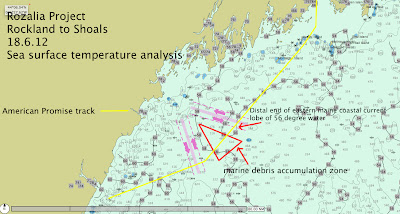Rozalia Project for a Clean Ocean
Discovering Garbage Patches in the Gulf of Maine
Rozalia Project for a Clean Ocean recently conducted a research cruise on the sailing research vessel American Promise. On June 11th 2012, while on passage to Frenchboro, ME from Kittery, ME the crew of American Promise observed large accumulations of seaweed, wood and plastic floating marine debris in the area of 43° 20.50 N, 69° 50.20 W. These accumulations of organic and manmade matter extended for several miles on a northwest to southeast axis.
On the return journey from Rockland to the Isle of Shoals on June 18th 2012, we used a foam current model and sea surface temperature analysis from Tidetech to determine the potential location of marine debris accumulation. As predicted by our analysis we observed the marine debris accumulation zone in the area of 43° 21.71N, 69° 41.11W. These marine debris accumulations again extended for several miles on a northwest to south east axis.
The Maine coastal current, as shown by the current model below, had its distal end in the area of debris accumulation. The lobe of cold water (56 degrees) is a good indicator of the presence of the Maine coastal current. This current collects debris from the waters of Nova Scotia, New Brunswick, and Maine and flows SW along the Maine coast. In the area of observed accumulation, the Maine coastal current peters out to zero, thus becoming a probable marine debris accumulation zone.
Tidetech Gulf of Maine Current Analysis 06.18.12 (click image to enlarge):
Tidetech Sea Surface Temperature analysis 06.18.12 (click image to enlarge):
The marine debris accumulations consisted of seaweed, wood in form of logs and branches, rope, net, plastic oil cans, plastic water bottles, lobster claw bands, Hooksett disks, plastic bags, plastic buckets, bleach containers and various miscellaneous unidentifiable pieces of plastic (photo right).
The ability to identify accumulations of marine debris via current and temperature analysis is part of the cornerstone of Rozalia Project’s mission to clean up our oceans of this marine trash.
Rozalia Project believes that the oceans can be cleaned of manmade marine debris by identifying and locating accumulations, then using low bycatch marine debris nets remove this debris from the ocean.
Rozalia Project is currently testing a marine debris removal prototype called the Baleen Basker off the waters of the Isle of Shoals. Stay tuned on Rozalia Project’s Facebook page as well as this blog for up to date news and photos of the Baleen Basker, marine debris pick up, education and research from the surface to the seafloor.
James Lyne
Rozalia Project for a Clean ocean



No comments:
Post a Comment